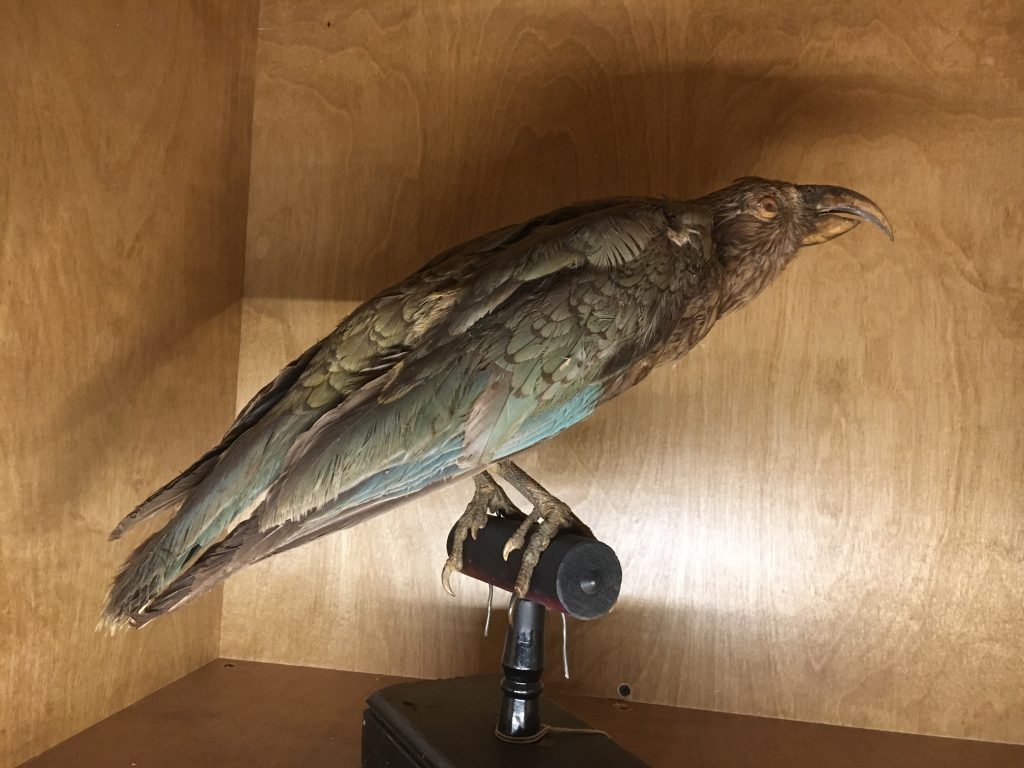It’s October, time to take our yearly dose of fright around the campfire and let out all our heathenish mischief before we have to act like angels during the holidays, right? Yes, we need October. But honestly it’s not because we’re all evil. The fact is that scaring the whits out of our friends and family members brings us closer to them. The thing that makes scary stories so much fun is the sense of security you have, sitting in a circle of trusted loved ones. So, to help readers of this blog in the unusual tradition of frightening the ones you love, I thought I’d present some scary stories from the true master of horror: Mother Nature.
Pictured above is a Kea, a parrot native to New Zealand. But it’s not an ordinary parrot, this bird is a swift, intelligent thief, vandalizer and even killer! Until the 1970’s these birds actually had a bounty on their heads because a small number of them developed the habit of using their long, pointy beaks to tear into the backs of sheep and extract nutritious fat. Just imagine for a minute that you’re a New Zealand sheep hearder, living isolated in the mountains. You discover mysterious wounds appearing on the backs of your sheep. You would notice if an animal were attacking your flock during the day, so the attacks must be happening at night. One night you stay out in the field, nervously awaiting the return of the ravenous beast that has been attacking your sheep. You go to investigate some strange noises, and come upon this sight:
Enough sheep died from infections after these attacks that a bounty was paid to anyone who turned in Kea bills, more than 150,00 of the animals were subsequently killed, leaving the species threatened. When it was discovered that there were only about 5,000 of these animals left alive in the mid-1970’s, people’s attitudes began to change.
These days Keas are protected. They still maintain a reputation for being mischievous, but kind of like raccoons here in the United States, Keas have become the Robinhood of pests. They’re very intelligent, they have been observed using sticks as tools to set off traps and steal the bait! They are also innately curious, leading them to explore unattended backpacks, purses and articles of clothing, sometimes flying off with random objects contained within. They also have a habit of prying apart the rubber seals around car windows. To be honest, they basically do a lot of the annoying stuff I did when I was a kid, and probably what some of you readers did too. In fact, that’s probably what has encouraged so many New Zealanders to support efforts to conserve these animals. Many humans can relate to an animal whose curiosity sometimes leads it to destructive behavior.

An adult Kea (Nestor notabilis) perching on a rock while it was snowing at Arthur’s Pass, New Zealand. Author: Alan Liefting. Source: Wikimedia Commons.
But there is still that problem of Keas literally tearing into the backs of sheep like some sort of zombie-bird. That behavior can be explained by the Keas harsh habitat. Keas are the only parrots in the world to live in an alpine habitat. They live high in the mountains, where food can be tough to find, especially fatty food like nuts and the carcasses of animals, which Kea have been observed eating in the wild as an important part of their diet. Life is so difficult in the wild that only about 40% of Kea make it to adulthood. Being intelligent animals, the Kea will take any opportunity they can to get more nutrition for less effort. Some of these hungry birds discovered that they can get all the fat they need from sheep. So these animals aren’t really horrific, soulless, bird monsters, they’re just really hungry.
The thing about nature is that although there are many scary creatures out there, they all exists for a reason. There is no such thing as an evil animal, just animals that have a hard time dealing with human interaction. I can definitely relate to that. The Kea is a prime example of an animal that filled an important niche in its natural environment, but has become a pest in a landscape modified by human habitation.
Next week we will feature another creepy creature that is just as misunderstood as Keas, but in the other direction. Stay tuned for a discussion of how sea stars are actually horrible killing machines!









